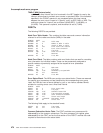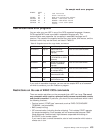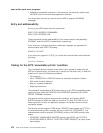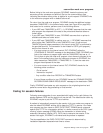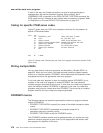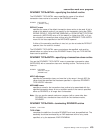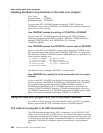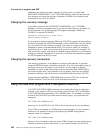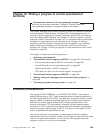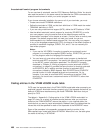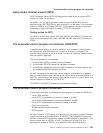
notification that service has been restored. To achieve this, you could code
RECOVNOTIFY(MESSAGE) in the TYPETERM definition, and then use the node
error program to change the recovery notification to NONE for the relatively few
terminals that are not to be notified.
Changing the recovery message
If you define a terminal with RECOVNOTIFY(MESSAGE) in its TYPETERM
definition, a recovery message is sent to the terminal after takeover. By default, for
an XRF takeover, this is the following CICS-supplied message in BMS map
DFHXRC1 of map set DFHXMSG:
CICS/ESA has recovered after a system failure.
Execute recovery procedures.
For a persistent sessions recovery, BMS map DFHXRC3 is used; this map prefixes
the above message with CICS/ESA message number DFHZC0199. You can specify
your own map set in the node error program if you want to change the recovery
message for some of the switched terminals. This could be useful, for example, if
signon security is in force and you want to tell terminal users to sign on again. The
map set that you specify must have an installed program definition. If you choose to
change the recovery message for all terminals, it would be more efficient to replace
the CICS-supplied map with your own.
Changing the recovery transaction
The recovery transaction, to be started at a terminal after takeover, is specified
using the RMTRAN system initialization parameter. This is the most efficient way of
specifying a recovery transaction for the network. You can specify a different
transaction for some of the switched terminals by overwriting field TWAXTRAN in
the communication area. The transaction that you specify must have an installed
transaction definition, and the terminal must be defined with the option ATI(YES).
If the transaction specified in TWAXTRAN does not exist, CICS tries to start the
CSGM transaction. If this also fails, CICS terminates the session.
Using the node error program with VTAM generic resources
The EXEC CICS ISSUE PASS command can be used (either from an application
program, or by means of CECI) to disconnect a terminal from CICS, and transfer it
to the VTAM application specified on the LUNAME option. For example, to transfer
a terminal from this CICS to another terminal-owning region, you could issue the
command:
CECI ISSUE PASS LUNAME(applid)
where applid is the APPLID of the TOR to which the terminal is to be transferred.
If your TORs are members of a VTAM generic resource group, you can transfer a
terminal to any member of the group by specifying LUNAME as the generic
resource name. For example:
CECI ISSUE PASS LUNAME(grname)
where grname is the generic resource name. VTAM chooses the most suitable group
member to which to transfer the terminal. (If you need to transfer a terminal to a
the node error program and XRF
482
CICS TS for OS/390: CICS Customization Guide



